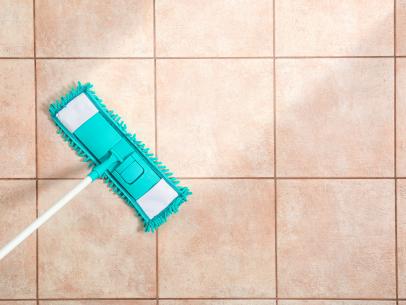Have you ever stared at your grimy tile floor, wondering if there’s a magic potion that can erase the stains and grime? Maybe you’ve even considered grabbing the bleach, that powerful cleaning agent that’s a staple in many homes. But before you unleash the bleach on your tiles, hold on! There are some things you need to know.

Image: home.alquilercastilloshinchables.info
Bleach can be a powerful cleaning tool, but using it improperly can damage your floors and even pose a health risk. This guide will delve into the pros and cons of using bleach on tile floors and provide you with all the information you need to make an informed decision.
The Pros and Cons of Using Bleach on Tile Floors
Bleach, with its strong disinfecting and bleaching properties, is a popular choice for cleaning many surfaces, including tile floors. But before you grab your bleach and get to scrubbing, consider both the advantages and disadvantages:
Pros:
- Effective Disinfection: Bleach is a powerhouse against bacteria, viruses, and mold, leaving your floors clean and hygienic.
- Removing Stains: Bleach is adept at breaking down stubborn stains, making it ideal for removing discoloration from organic materials like food spills or pet accidents.
- Brightening Tile: Bleach can brighten the grout and tiles, giving your floors a fresh, clean look.
Cons:
- Potential Damage: Applying bleach to certain types of tile, particularly natural stone like marble, can etch or dull the surface.
- Fumes and Odors: Bleach produces strong fumes that can irritate eyes, nose, and lungs, especially in poorly ventilated spaces.
- Chemical Exposure: Bleach is a harsh chemical and prolonged or repeated exposure can irritate the skin, eyes, or respiratory system.
- Color Fading: Bleach can affect the color of certain grout or tile, causing it to fade or change shade, especially if the tiles are not colorfast.
Choosing the Right Tile for Bleach Cleaning
Before you even think about bleach, understanding the type of tile is crucial. Some tiles are bleach-friendly, while others are better suited for gentler cleaning methods:
- Porcelain and Ceramic Tile: Generally, these are considered safe for bleach cleaning.
- Natural Stone (Marble, Granite, Limestone): Avoid using bleach on these types of tiles, as it can damage their surface and dull their shine. Opt for mild cleaners formulated specifically for natural stone.
When Bleach Might Be a Good Option
While bleach is not a universal cleaning solution, there are specific situations where it may be the best choice:
- Heavy-duty Sanitation: For areas where you need to eliminate dangerous bacteria like Salmonella or E. coli, bleach can be a valuable tool. For example, in areas with young children, pets, or someone with a compromised immune system.
- Stubborn Stains: If you have a stubborn stain that you can’t remove with regular cleaning methods, bleach can tackle those tough spots.

Image: phenergandm.com
Using Bleach Safely
If you decide to use bleach, safety is paramount. Follow these steps to minimize risks and ensure effective cleaning:
- Dilute Correctly: Never use bleach straight from the bottle. Always dilute it with water according to the manufacturer’s instructions. A general rule is to mix one part bleach with ten parts water.
- Test an Unnoticeable Area First: Before applying bleach to your entire floor, test it in an inconspicuous area to see if it causes any discoloration or damage.
- Wear Protective Gear: Wear gloves, a mask, and eye protection to protect yourself from the fumes and splashes.
- Ventilate the Area: Ensure proper ventilation by opening windows or using a fan to remove bleach fumes.
- Rinse Thoroughly: After cleaning, rinse the floor thoroughly with clean water to remove any bleach residue.
Alternatives to Bleach
If you’re hesitant about using bleach, there are several alternative cleaning solutions that are just as effective:
- White Vinegar: Vinegar is a natural disinfectant and can also clean and brighten tile floors.
- Baking Soda: Baking soda is a gentle abrasive that can help scrub away tough dirt and grime without harming the tile.
- Commercial Tile Cleaners: There are many commercially available tile cleaners formulated specifically for tile floors and grout. Choose products that are safe for your tile type and avoid those containing harsh chemicals.
Maintaining your Tile Floor
Regular cleaning is key to maintaining your tile floors. Here are some tips:
- Sweep or Vacuum Regularly: Remove loose dirt and debris to prevent scratches and wear.
- Mop Often: Mop your floors with a gentle cleaner designed for tile at least once a week.
- Deep Clean Regularly: Every few months, give your floors a deep clean with a cleaner specifically designed for grout and tile.
Can You Use Bleach To Mop Tile Floors
Conclusion
While bleach can be an effective cleaning solution for tile floors, it’s important to use it with caution and consider the potential drawbacks. By understanding the pros and cons, choosing the right tile for bleach cleaning, and utilizing safe practices, you can effectively disinfect and clean your tile floors without causing damage. Remember, alternative cleaning methods are available, and regular maintenance is crucial to keeping your tile floors looking their best.
If you have any concerns or questions about cleaning your tile floors, consult a professional cleaning service or a tile specialist for personalized guidance.






